Statistics and Frequently Asked Questions
The Villages for the Homeless organization wants to try a fundamentally different approach that involves creating a compact, nearly car–free pedestrian village where all the agencies and efforts to help could be concentrated and better organized. The village should be a short distance outside of town on a bus stop. There could be various job creation enterprises, including a community garden, construction and maintenance related to the village, cottage industries related to recycling, and a labor center where employers can hire certified workers.
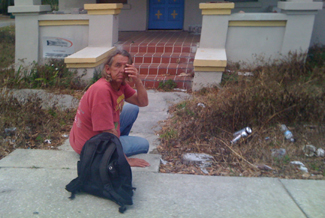
Many people in the cities want to help, but they do not want to see homeless people wandering their streets and engaging in various activities that contribute to a lower quality of life in their communities. We advocate building a village with a full range of services and amenities designed to house and care for the 10 to 18% of the adult homeless who are chronically homeless–most of whom have permanent mental and/or physical disabilities–as well as provide work, shelter, counseling, and rehabilitation for the 82 – 90% of the temporarily homeless who can contribute and be successfully reintegrated into society. The U.S. has the highest incarceration rate in the world, an astounding 700% higher than Canada or Europe. High numbers of people in jail is not only ruinously expensive, but indicative of failed social policies. Villages for the homeless could partially offset these failures by functioning as “halfway homes” for some of the 7.2 million people within the criminal justice system who are currently behind bars, on parole, or on probation.
At any given moment in time, 3 million Americans (1% of the population) are homeless. During the year between 5 and 8 million Americans experience at least one night of homelessness. Eighty percent exit homelessness within one month, but 10% are homeless for two or more months, and another 10% are chronically homeless. Chronic homelessness is defined as being homeless for more than 1 year or homeless more than 4 times in 3 years. Most of these people could be helped more effectively with villages for the homeless.
Q. That sounds great, but how are we going to pay for it?
A. The real question is “How are we going to afford the same failed programs, especially in a poor economy?” Here is a list of the different sources of funding:
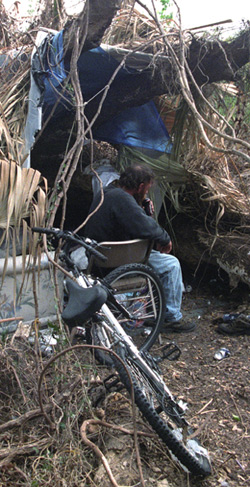
- 1. Working Homeless: The homeless themselves would contribute a major portion of the costs, with contribution of their income and labor. Small cottage industries can be started. For example, The Volusia– Flagler County Coalition for the Homeless Inc. spent $42,186 for clothing in one year (2004). Donated clothes to the village could form the basis of a thrift shop run by the residents themselves and actually produce an income.
- 2. Consolidated Services: In the case of Flagler/Volusia, the 19 different agencies would pool their resources in a centralized location in order to make better use of the funds they receive.
- 3. Savings from other Services: The police, fire, medical services, prison system, city and county services and other division would all realize savings from inefficient homeless related services. A village medical clinic could take care of most health needs and preventative care, thus precluding expensive emergency room visits that are paid for by taxpayers.
- 4. Found Money: The homeless who have lost their identity would have it restored, and if they are eligible for federal or state aid, they will receive it and pay the village for services.
- 5. Government Funds: As a new model for solving the needs of the homeless, villages for the homeless will no doubt attract government grants. The poor economy will increase the need for such services and make it imperative that less effective practices be ended. A successful village model would be emulated across the country.
- 6. Increased Private Help: A lot of people want to help, but they don’t want to help ruin their community by contributing to or encouraging vagrancy in their own neighborhood. These so-called “NIMBYs” (Not In My Backyard) are perfectly justified. No one wants vagrants, littering, prostitution, drugs, violence, and various criminal or unsavory activities degrading their neighborhood. Many people who were otherwise unwilling to create a magnet for homelessness in their own backyard will be eager to help once a village is built that will help the homeless as much as it helps the greater community.
- 7. Incremental Cost: A New Pedestrianism–style village would be built as needed. Once the infrastructure in place, the costs would be incremental, as would the building. Funding could come from municipalities and counties as it is demonstrated that money is being saved elsewhere.
- 8. Municipal Contributions: All of the cities in the area will save money on services related to the homeless. A portion of those savings should go toward the Village, which provides benefits to all the cities in the region.
- 9. Miscellaneous Benefits: The generous private charities and individuals can give to a central village and direct any panhandlers to the village, thus vastly reducing the urban presence of the homeless that is decimating local neighborhoods and turning central business districts into slums. This would improve our cities and create a cycle of improvement to counteract the trend toward inner city decay. Homelessness, especially high visibility street homelessness, costs a fortune in lost economic development.
Q. What will keep Tiger Bay Village from becoming a magnet for homeless people all over the country? Isn’t this going to cause more homeless people to move to our area?
No one wants the homeless in their town, but in order to work, it has to attract the homeless. This is why we need a well–rounded rural solution that everyone can support. The village will be built incrementally and take care of locals first. Then it will serve as a model for other communities to help their own homeless. We shouldn’t ignore a viable solution because we fear success.
Q. Is anyone else trying to group all the social services together for maximum effort?
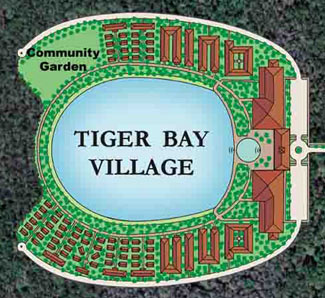 Yes, there are examples in Miami, San Diego, Savannah, and Dallas. “The Bridge“ in Dallas may be the closest thing to Tiger Bay Village that we can think of, and is one of several
“shopping malls of social services” where social services are consolidated for maximum efficiency. Mike Faenza, the CEO of Metro Dallas Homeless Alliance opened a non–religious,
campus–like, sleep–in shelter on the edge of downtown Dallas in 2008. The shelter will house 300 and has five brick buildings surrounding a central courtyard.
Mike shares our goal of ending homelessness, but he’s still encountering resistance from downtown business owners.
Yes, there are examples in Miami, San Diego, Savannah, and Dallas. “The Bridge“ in Dallas may be the closest thing to Tiger Bay Village that we can think of, and is one of several
“shopping malls of social services” where social services are consolidated for maximum efficiency. Mike Faenza, the CEO of Metro Dallas Homeless Alliance opened a non–religious,
campus–like, sleep–in shelter on the edge of downtown Dallas in 2008. The shelter will house 300 and has five brick buildings surrounding a central courtyard.
Mike shares our goal of ending homelessness, but he’s still encountering resistance from downtown business owners.
He intends to reach all kinds of homeless people. As he says, “The more times a person has been in jail, been arrested or beaten up, the more welcome he will be at the center.” He even offers a building with one side open for the shelter–resistant homeless who don’t like to feel confined. Click here to read about the Bridge. A more recent story in the Dallas Observer News attests to the success of The Bridge in being a one stop shop for the homeless. Click here to read more.
Q. I read about a program where the homeless are given apartments. Why not just do that?
A. That’s okay for families and some of those who recently lost a place to live, but it has not worked so well with the chronically homeless. In the article linked above, Tom Dunning, Dallas’ homeless czar said of the apartment giveaway program: “In six months, many of the apartments had been trashed, the furniture had been sold, and the copper had been ripped out.” He added, “What we found from talking about chronic homelessness is that once a person has been on the streets for many years, it’s hard to transition them into single–room occupancy or an apartment without proper counseling.”
Q. Who would go there?
A. The adult chronic or temporarily homeless, those prison bound, or those exiting prison, those in substance abuse programs, the mentally– ill, sex offenders with no where else to go, and others who are not able to fit into an automobile-dominated society. Any person temporarily or chronically unable to make it in the wider society who would benefit from a cohesive, village that covers the full psychological and psychiatric range of needs, including work opportunities.
Q. If you take all comers, how do you keep those with substance abuse issues and other troublemakers from spoiling the whole village?
A. The first stop for many coming into the village will be the drug and alcohol abuse rehabilitation center next door. The more problematical residents (especially those still using drugs and alcohol who are not ready for rehabilitation) would live on the north side of the lake, and the more responsible ones would live on the south side of the lake. Those who show they can be more responsible will get more privileges (such as access to the village center, use of the swimming lagoon, better housing, and better food).
For the ones who commit crimes there is the county jail and state prison just down the road. The village could take on those sentenced in drug court instead of having to send them to prison. About half of all prisoners are jailed for drug related offences. Drug abuse is a health issue and should be treated as such. Every reputable study done on the subject shows that treatment is a far more cost effective approach. This would be a good place to research treatment methods for addiction. The War on Drugs has failed miserably, and the Mexican Drug War has now spread to 195 American cities with kidnappings, murders, and even beheadings. We need to find another approach.
Q. If 2/3 of the U.S. homeless have mental health and/or substance abuse issues, why aren’t they being treated in institutions, like they used to be?
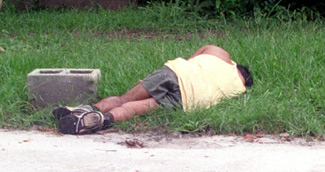
A. For thirty years the U.S. has been undergoing de–institutionalization, a 30–year long process of closing down state mental hospitals throughout the country. The choice for those with mental and substance abuse issues who don’t have severe schizophrenia or mental illness is usually between dying on the streets or vegetating in jail. There should be something in between. The proponents of de–institutionalization favor “a less restrictive environment” and this is exactly what a village for the homeless would provide. Not only will it be less restrictive, but it will also provide a vast range of benefits that will protect those who are living on the streets while also protecting the larger community from them.
Q. What about families and children?
A. Women and children are the fastest growing segment of the homeless population, and this fact has been noted by the U.S. Conference of Mayors each year for the past several years. Twenty–three percent of all homeless are members of families with children. For the sake of the children, this segment should be re-assimilated back into the community as soon as possible. The other 77% of the homeless could immediately be helped by Villages for the Homeless. A pedestrian village could also be constructed for needy families with children, but this should be done as an infill development so as to take advantage of schools and keep the families within the larger community.
Q. What percentage of the homeless work?
A. In Volusia County, 37% are employed but they do not earn enough money to pay for rent, or the work is not consistent, or they cannot afford a first month, last month and security deposit. They also sometimes have an arrest record that make landlords reluctant to rent to them.
The median monthly income for a homeless person is $300, which can be from panhandling, work income, or public aid. Tiger Bay Village would charge the homeless a percentage of their income for food and housing, and endeavor to increase their income through various methods.
Q. What is the story on affordable housing?
A. The number of housing units affordable to extremely low income households fell by almost 1 million between 1999 and 2001. Until 2008 this did not change, so we assume that half a million affordable units per year were lost until 2008, when the housing bubble popped. Since then, the affordability index has increased and this might eventually help some of the temporarily homeless. On the other hand, the number of foreclosures has been skyrocketing, which could foster more homelessness. The current recession is causing many to lose their jobs as well as their homes. The housing starts have fallen, but the U.S. population still continues to rise at upwards of 3 million per year.
Q. What are the facts about homelessness in Volusia and Flagler Counties?
According to the Flagler-Volusia Coalition for the Homeless, which conducts an annual survey, these statistics have been compiled:
In 2006, 300 people were fed 6,000 meals per moth, seven days a week by Halifax Urban Ministries and 22 faith groups in a building in the Daytona Beach “Bridge of Hope” Hot Meal Program. (Homeless Assistance Center, 316 North Street, Daytona Beach, FL 32114. 386 323-1784.)
From here the homeless are connected with counseling services to address substance abuse addiction and domestic violence issues. There are also attempts to attenuate issues related to clothing, laundry, personal hygiene, and haircuts. They also have a Work Force Development office to address employment and work training. They work with Halifax Hospital on patient assistance, the DCF for mainstream benefits, and with the UCF School of Nursing for basic health services. They also work with Serenity House and Stewart Marchman and ACT for mental health and substance abuse counseling, and with domestic violence shelters, and other issues.
There were 400 volunteers helping each month in 2006. Thirty percent of the people had lost their identification. Beginning in 2006, families with children and the medically needy get put up in hotels at a cost of $25 per night.
A night in a shelter ranges from $11 per day to $28 per day. A night in jail costs from $53 to $94 per day, with the cost of booking into jail in Central Florida being $764 (according to Sheriff Rutherford, Duval Co). Many homeless clients are arrested more than 5 times per year. Booking a homeless person 5 times in one year would pay for a whole year of shelter.
A day in the hospital for a homeless person costs taxpayers $1,278.
Each year, every coalition in the nation, is required to conduct a 24– hour point in time census. That means going out under freeway overpasses, and into the woods, and into parks at night and trying to find every homeless person and complete an interview with each one. This must take place in January each year. In 2005, we came up with the number of 2,667 homeless in the two-county service area of Volusia and Flagler.
Coalitions are also responsible for counting all the beds and services available for those homeless. There are 36 emergency shelter beds to serve the two counties – and not one single bed for homeless families, although there are 1,371 homeless children registered in Volusia County Schools. About 850 of whom attend school each day. This is a nearly 20% increase in the number of homeless children since last year.
Here are some characteristics of the homeless:
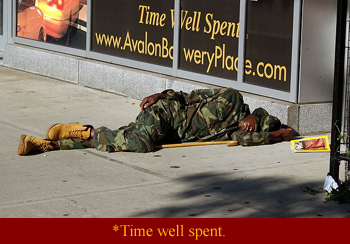
- 23 percent are Veterans
- 26 percent have acute health problems – like TB
- 46 percent have chronic health problems – like diabetes
- 80 percent of the women are victims of abuse
We don’t have all the answers or even all the stats, but we know enough to know that villages for the homeless will work better than the status quo. To learn more about how to make it better, we actually have to build one.
If your question has not been answered here, or you would like more information please go to the media page. If your question is still unanswered then please write us at info@villagesforthehomeless.org